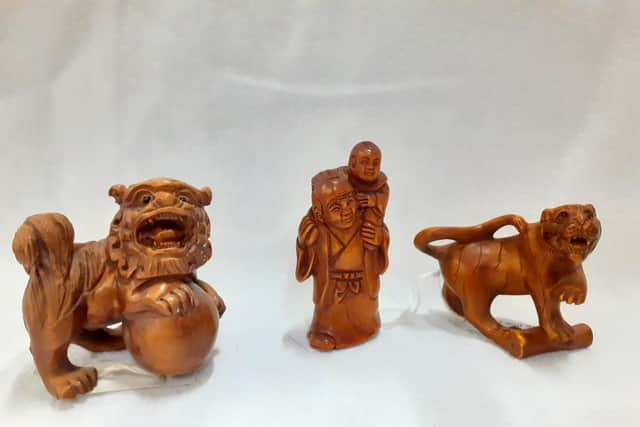Japanese miniture carvings can fetch more than £100,000 at auction
and live on Freeview channel 276
Still being responsibly cautious in the face of rising Covid cases, I appreciate now, more than ever, the freedoms we had taken for granted pre-Covid.
Widening our horizons again made me realise how much our gaze has been focussed closer-up over the last year. This puts me in mind of ‘netsuke’, beautiful Japanese miniature sculptural pieces created in the 17th century.
Advertisement
Hide AdAdvertisement
Hide AdFrom ne: ‘root’ and tsuke: ‘to fasten’, and pronounced ‘net-ski’, netsuke were toggles designed to keep pouches safely fastened to men’s kimono sashes, in lieu of pockets.


Initially plain, natural gourds, the decorative netsuke we think of today developed across the 18th century, beautifully decorated items with elaborate carving, lacquer work, or inlays of rare and exotic materials, including shell, coral, ivory and semi-precious stones.
The detailed workmanship can be outstanding, despite their small size (one to two inches). The best sculptors would display their skill by carving complicated pieces from a single chunk of ivory, for example, a working miniature abacus or a man holding a tiny birdcage with even tinier birds inside. The reason for the lasting popularity of netsuke is obvious: the charm of a work of art that fits into your palm, with a personality and story all its own.
Knowledgeable collectors look for compactness, a design that appears good from any angle, and the cord holes must not interfere with the piece. Some antique netsuke are signed, most are not, and many are copies.
Advertisement
Hide AdAdvertisement
Hide AdThere are many styles and types, ranging in price from a few pounds to literally thousands of pounds, depending on the popularity of the carver and the intricacy and details of the carving.
Recently a horse carved by Tomotada fetched £140,000.
There are many pieces of original netsuke on sale at the centre, look for them in lit glass-fronted cabinets, where they can be displayed to their full delicate beauty, and you might see delicately caved snakes, turtles, rabbits, dragons, people and rats peeking out at you!
I was once advised: “In your first years of collecting, spend more on books about netsuke than you do on netsuke themselves!” Luckily the internet has made more resources freely available for this wonderful hobby you can start on, appropriately, a relatively small budget.